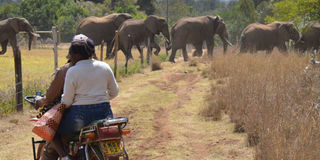East battles south over ivory trade ban

A boda boda rider makes a U-turn after coming across a herd of elephants that were being driven back to the forest in Laikipia County on March 20, 2019. PHOTO | STEVE NJUGUNA
Kenya wants the entire population of elephants in Africa afforded the strictest possible protection.
Currently, only elephants in East Africa are placed under Appendix I of the Convention on International Trade in Endangered Species (CITES), a listing that gives them absolute protection. This means that their parts can only be imported or exported for scientific research.
Elephants in southern Africa, on the other hand, are listed in Appendix II, which allows limited trade in their specimens. However, this could change if the Kenya Wildlife Service (KWS) submission to CITES to place all elephants under Appendix I is approved. Appendix I lists species that are the most endangered.
KWS Spokesperson Paul Gathitu says that the current diverse tiers of protection that allowed Southern African states to trade in selected elephant products have hindered efforts to control the ivory trade that decimated African elephant populations in eastern Africa before CITES members placed them under the most stringent protection.
Kenya’s proposal pits it against southern Africa countries that want restrictions slackened. South Africa, Botswana, Namibia and Zimbabwe have proposed an amendment that will remove restrictions and allow for international trade in registered raw ivory from elephants from their countries. But Kenya’s conservationists worry that this might drive demand for ivory from across the continent when it needs to be eliminated.
“We are asking for a transfer of the populations of Botswana, Namibia, South Africa and Zimbabwe from Appendix II to Appendix I. We want them to stop trading in specimens of elephants,” says Mr Gathitu.
PROTECTION
In their submissions to CITES, South African countries have argued that their populations are relatively stable. However, Mr Gathitu says that in the absence of a total ban, elephant parts are being moved from countries with unsustainable populations, to those with sustainable populations, before being shipped to markets overseas.
“The black market has continued to thrive because some countries are allowed to sell, complicating the poaching crisis for the rest of us,” says Mr Gathitu, adding that CITES needs to come up with ways of dealing with ivory stockpiles.
But the proposals to CITES are only a fraction of the battle, with the real battle awaiting East African States at the 18th meeting of the Conference of the Parties (CoP) in Colombo, Sri Lanka, where the African elephant range countries will battle it out for a position, between 23rd May and 3rd June, 2019.
At the same conference, Kenya, together with 30 other African states, will also push for giraffes to receive special protection.
According to the African Wildlife Foundation’s Vice President for Species Protection Philip Muruthi, the reticulated giraffe, one of Kenya’s signature wildlife species, has declined steadily and is now considered endangered. Maasai and Rothschild giraffes make up the remainder of Kenya’s total giraffe population, which has declined by up to 67 per cent since the 1970s.
Already, in a new report by the International Union for Conservation of Nature (IUCN), the giraffe has been moved from the list of “Least Concern” to “Vulnerable” in its Red List of Threatened Species.
Around the continent, two sub-species of the giraffe have been reclassified as “Critically Endangered”. Despite their decline, hunting remains legal in countries such as South Africa, Namibia and Zimbabwe, with tourists from Russia, the US and European countries such as Germany paying thousands of dollars for hunting safaris.
“It is a fierce battle,” says Mr Gathitu, adding that Kenya is calling on the EU to back its proposal.


